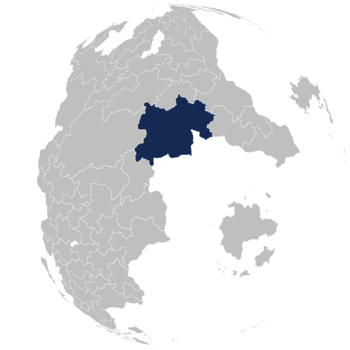Sartoria
This article is incomplete because it is pending further input from participants, or it is a work-in-progress by one author. Please comment on this article's talk page to share your input, comments and questions. Note: To contribute to this article, you may need to seek help from the author(s) of this page. |
Principality of Sartoria Principato di Sartoria | |
|---|---|
|
Flag | |
 | |
| Capital | Messelia |
| Largest city | Chiavere |
| Official languages | None |
| Other languages | Sartorian |
| Demonym(s) | Sartorian |
| Government | Federal Elective Parliamentary Monarchy |
• Princess | Giulia |
• First Councillor | Luciana Bergamaschi |
• Second Councillor | Fiorella Scola |
• Senate Speaker | Roberta Casellati |
• Chief Justice | Mario Boldrini |
| Legislature | Senate |
| Establishment | |
• Treaty of Messelia | 1768 |
• Merger Treaty | 1908 |
• Treaty of Regù | 1921 |
| Area | |
• Total | 3,078,415 km2 (1,188,583 sq mi) |
| Population | |
• Estimate | 186,723,882 |
• Density | 60.7/km2 (157.2/sq mi) |
| GDP (nominal) | estimate |
• Total | S/ 7,357 trillion |
• Per capita | S/ 39,400 |
| Currency | Vallo (v) |
| Time zone | UTC-5 |
| Date format | DD/MM/YYYY |
| Driving side | left |
| Internet TLD | .sr |
Sartoria, officially the Principality of Sartoria (Sartorian: Principato di Sartoria) is a country in Central Arcadia. It is located southwest of the Artemid Peninsula, bordering Istria to the west, Meridia to the southwest, Adler and Delfina to the east, and the Sartorian Sea to the south. With over 186 million inhabitants, it is the most populous country in Arcadia, and the second most populous country in the world.
Sartoria has long been settled by a number of civilisations, most notable the Artemid Empire in the east and the Vasarian Empire in the centre and southwest. Unification began in the 18th century when Messelia and Verale, two of the leading industrial realms at the time, merged into a single country called Sartoria. As more realms joined, the country grew from a confederacy to a federal principality.
By the late 19th century, present-day Sartoria was divided into several states; the main ones, in terms of size, population, economic development and military power, were Sartoria, North Sartoria and Laminia. Following the Sartorian-Laminian War and the Peninsular War, Laminia was split into two and annexed by Sartoria and North Sartoria, who then merged into a single country through the 1908 Merger Treaty. Unification was finally concluded when Tavoletro acceded to the Principality, amid concerns that Sacuri Thought was getting out of control in the area.
In the 1920s and 1930s, Sartoria waged war on the Sacuri, the third such conflict in its history, after the First War in the 13th century and the Second War in the 17th century. When the Order of the Bloody Hand conquered large swaths of the Eastern Realms and invaded Messelia, the Sartorian Government began an unprecedented military campaign that resulted in the final defeat of the Sacuri in 1935. After the War, the Cleansing Act allowed the Government to erase all Sacuri influence from society.
In the 1960s, Sartoria fought in the Great War alongside Parthenopias and Selene, where the Iron Alliance was kept from expanding its territory beyond their national borders, though at great cost in terms of lives and infrastructure. After the War, the three countries formed the Artemian Union, a political, military and economic alliance that survives to this day.
Today Sartoria is the world’s largest economy, with a very high level of human development and high rankings in socioeconomic indexes. It is a member of the World Society, the Artemian Union and several other international organisations.
